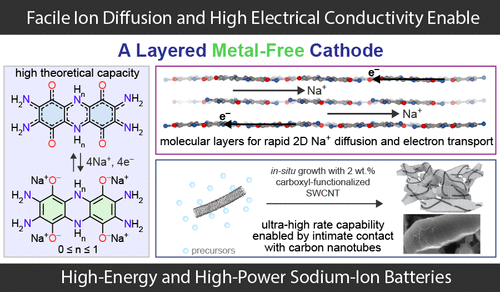Science. High-Energy, High-Power Sodium-Ion Batteries from a Layered Organic Cathode

Sodium-ion batteries (SIBs) attract significant attention due to their potential as an alternative energy storage solution, yet challenges persist due to the limited energy density of existing cathode materials. In principle, redox-active organic materials can tackle this challenge because of their high theoretical energy densities. However, electrode-level energy densities of organic electrodes are compromised due to their poor electron/ion transport and severe dissolution. Here, we report the use of a low-bandgap, conductive, and highly insoluble layered metal-free cathode material for SIBs. It exhibits a high theoretical capacity of 355 mAh g–1 per formula unit, enabled by a four-electron redox process, and achieves an electrode-level energy density of 606 Wh kg–1electrode (90 wt % active material) along with excellent cycling stability. It allows for facile two-dimensional Na+ diffusion, which enables a high intrinsic rate capability. Growth of the active cathode material in the presence of as little as 2 wt % carboxyl-functionalized carbon nanotubes improves charge transport and charge transfer kinetics and further enhances the power performance. Altogether, these allow the construction of SIB cells built from an affordable, sustainable organic small molecule, which provide a cathode energy density of 472 Wh kg–1electrode when charging/discharging in 90 s and a top specific power of 31.6 kW kg–1electrode.
Copyright © 2025 American Chemical Society










